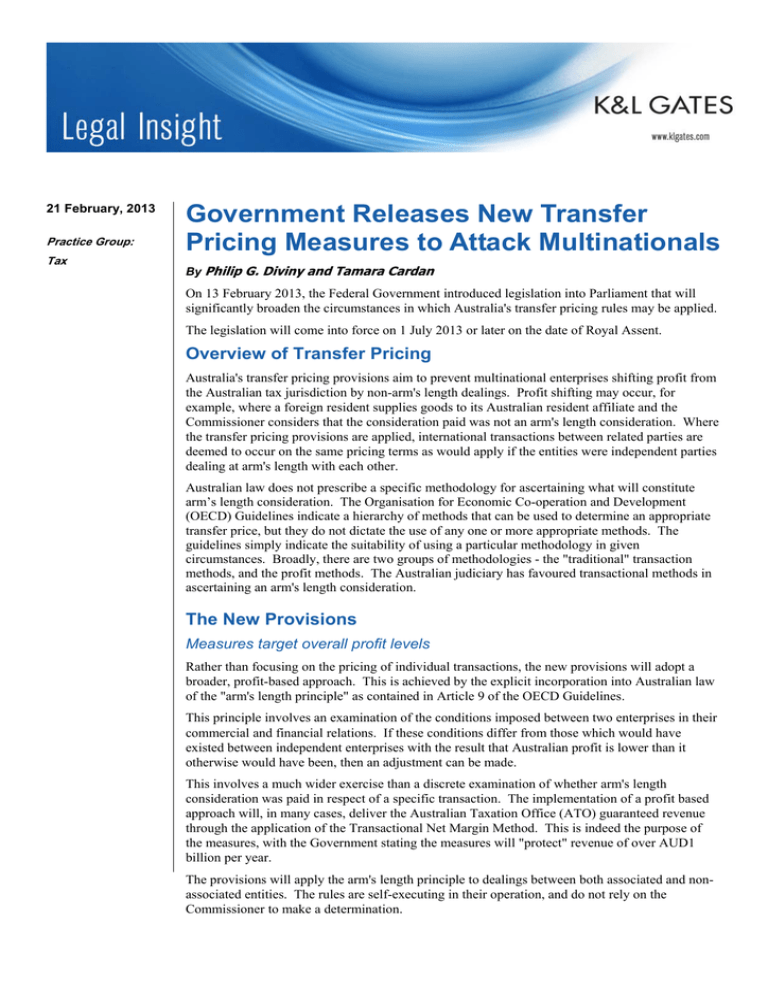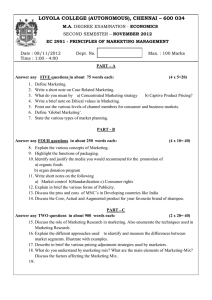
21 February, 2013
Practice Group:
Tax
Government Releases New Transfer
Pricing Measures to Attack Multinationals
By Philip G. Diviny and Tamara Cardan
On 13 February 2013, the Federal Government introduced legislation into Parliament that will
significantly broaden the circumstances in which Australia's transfer pricing rules may be applied.
The legislation will come into force on 1 July 2013 or later on the date of Royal Assent.
Overview of Transfer Pricing
Australia's transfer pricing provisions aim to prevent multinational enterprises shifting profit from
the Australian tax jurisdiction by non-arm's length dealings. Profit shifting may occur, for
example, where a foreign resident supplies goods to its Australian resident affiliate and the
Commissioner considers that the consideration paid was not an arm's length consideration. Where
the transfer pricing provisions are applied, international transactions between related parties are
deemed to occur on the same pricing terms as would apply if the entities were independent parties
dealing at arm's length with each other.
Australian law does not prescribe a specific methodology for ascertaining what will constitute
arm’s length consideration. The Organisation for Economic Co-operation and Development
(OECD) Guidelines indicate a hierarchy of methods that can be used to determine an appropriate
transfer price, but they do not dictate the use of any one or more appropriate methods. The
guidelines simply indicate the suitability of using a particular methodology in given
circumstances. Broadly, there are two groups of methodologies - the "traditional" transaction
methods, and the profit methods. The Australian judiciary has favoured transactional methods in
ascertaining an arm's length consideration.
The New Provisions
Measures target overall profit levels
Rather than focusing on the pricing of individual transactions, the new provisions will adopt a
broader, profit-based approach. This is achieved by the explicit incorporation into Australian law
of the "arm's length principle" as contained in Article 9 of the OECD Guidelines.
This principle involves an examination of the conditions imposed between two enterprises in their
commercial and financial relations. If these conditions differ from those which would have
existed between independent enterprises with the result that Australian profit is lower than it
otherwise would have been, then an adjustment can be made.
This involves a much wider exercise than a discrete examination of whether arm's length
consideration was paid in respect of a specific transaction. The implementation of a profit based
approach will, in many cases, deliver the Australian Taxation Office (ATO) guaranteed revenue
through the application of the Transactional Net Margin Method. This is indeed the purpose of
the measures, with the Government stating the measures will "protect" revenue of over AUD1
billion per year.
The provisions will apply the arm's length principle to dealings between both associated and nonassociated entities. The rules are self-executing in their operation, and do not rely on the
Commissioner to make a determination.
Government Releases New Transfer Pricing Measures to
Attack Multinationals
Documentary requirements
The new measures do not mandate the preparation or keeping of documentation, however failing
to do so will prevent a taxpayer from establishing a "reasonably arguable position". The
consequence is that a lack of documentary evidence will prevent the taxpayer from seeking to
mitigate administrative penalties imposed following a transfer pricing adjustment to its taxable
income.
As a practical matter, taxpayers will need to hold contemporaneous documentation to support their
transfer pricing position. This will need to include both contractual documentation and economic
analysis of the pricing policies. All documentation must be prepared before the lodgment of the
relevant tax return in order to support a reasonably arguable position.
Amendment period
The Commissioner will have a seven year amendment period under the new laws. Whilst this is
clearly preferable to the previous unlimited amendment period, it is still significantly longer than
other amendment time limits under the income tax laws.
Mutual agreement procedure
It remains to be seen how the new law will impact the current Mutual Agreement Procedures as
set out in Australia's tax treaties. These procedures may be invoked where a transfer pricing
adjustment in one country results in the same income being taxable in two jurisdictions. Where
multinationals apply for relief from double taxation under these procedures, the ATO will
negotiate with the overseas tax authorities to resolve the matter. Under transactional transfer
pricing provisions, this would involve adjustments to the consideration for a discrete transaction.
However, the new rules do not contain specific guidance as to how the adjustments to profit levels
will be linked to the numerous transactions between related parties, some of whom may not be
located in treaty countries. This may prove problematic in the effective use of the Mutual
Agreement Procedures.
Comment
The new rules will put substantial pressure on taxpayers to reconsider their transfer pricing
policies and the documentation that supports them. The ATO will have much greater power to
adjust a taxpayer's net profit levels and this power extends for up to seven income years.
The explicit incorporation of the OECD Guidelines into the new provisions will create practical
difficulties, as these guidelines are often updated by the OECD. This new legislation gives the
OECD Guidelines legal status.
In view of the changes, taxpayers will need strong transfer pricing policies and systems in place,
together with contemporaneous documentation that establishes the entity determined its taxable
income as if arm's length conditions had operated.
Authors:
Philip G. Diviny
philip.diviny @klgates.com
+61 3 9640 4221
Tamara Cardan
tamara.cardan@klgates.com
+61 3 9640 4311
2
Government Releases New Transfer Pricing Measures to
Attack Multinationals
Anchorage Austin Beijing Berlin Boston Brisbane Brussels Charleston Charlotte Chicago Dallas Doha Dubai Fort Worth Frankfurt
Harrisburg Hong Kong Houston London Los Angeles Melbourne Miami Milan Moscow Newark New York Orange County Palo Alto
Paris Perth Pittsburgh Portland Raleigh Research Triangle Park San Diego San Francisco São Paulo Seattle Seoul Shanghai
Singapore Spokane Sydney Taipei Tokyo Warsaw Washington, D.C.
K&L Gates practices out of 47 fully integrated offices located in the United States, Asia, Australia, Europe, the
Middle East and South America and represents leading global corporations, growth and middle-market
companies, capital markets participants and entrepreneurs in every major industry group as well as public
sector entities, educational institutions, philanthropic organizations and individuals. For more information
about K&L Gates or its locations, practices and registrations, visit www.klgates.com.
This publication is for informational purposes and does not contain or convey legal advice. The information herein should not be used or relied upon
in regard to any particular facts or circumstances without first consulting a lawyer.
©2013 K&L Gates LLP. All Rights Reserved.
3





